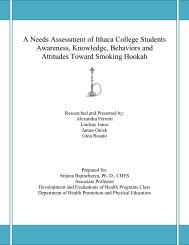Pay for Performance Ethical Issues
Pay for Performance Ethical Issues
Pay for Performance Ethical Issues
Create successful ePaper yourself
Turn your PDF publications into a flip-book with our unique Google optimized e-Paper software.
<strong>Pay</strong> <strong>for</strong> Per<strong>for</strong>mance Installment # 2<br />
April Mitchell & Colleen Lau<br />
<strong>Pay</strong> <strong>for</strong> per<strong>for</strong>mance is one solution being implemented to help decrease the cost of<br />
healthcare in the United States. Like many of the other solutions proposed, this plan has several<br />
issues. The widespread implementation of pay <strong>for</strong> per<strong>for</strong>mance will lead to many ethical issues<br />
<strong>for</strong> physicians to consider.<br />
Physicians swear by the Hippocratic Oath where they promise to uphold the standards of<br />
beneficence and nonmaleficence to all patients that they treat. Along with the Hippocratic Oath,<br />
physicians also have certain morals as their own internal motivators to offer the best of care to<br />
patients. The moment when physicians decide to join the pay <strong>for</strong> per<strong>for</strong>mance program, they<br />
have agreed to receive a certain amount of money <strong>for</strong> achieving certain goals and sometimes<br />
they are not medical goals. The point of the goals is to increase the quality of care offered to<br />
patients but physicians are already expected to offer the best quality of care to their patients due<br />
to the Hippocratic Oath. The incentive there<strong>for</strong>e acts as an external motivator and is the carrot<br />
that is dangling to coerce physician into offering better quality of care. This means that the<br />
moment that physician signs up to be in a pay <strong>for</strong> per<strong>for</strong>mance program, the first ethical issue<br />
that arises is that physicians are being coerced into changing their behavior in exchange <strong>for</strong><br />
money.<br />
After being in pay <strong>for</strong> per<strong>for</strong>mance programs <strong>for</strong> a period of time, another ethical issue<br />
that arises is physician trustworthiness. Physicians over a period of time may feel that they are<br />
entitled to the incentives offered through pay <strong>for</strong> per<strong>for</strong>mance programs and take advantage of<br />
the system. The trustworthiness of physicians is at stake because physicians may take advantage<br />
of the system and this leads to a breakdown in the trustworthiness of physicians. It can be<br />
expected that there will be physicians who will take advantage of pay <strong>for</strong> per<strong>for</strong>mance programs
<strong>Pay</strong> <strong>for</strong> Per<strong>for</strong>mance Installment # 2<br />
April Mitchell & Colleen Lau<br />
since there has been evidence of physicians in other countries with similar programs taking<br />
advantage of this payment system (Hartocollis, 2013).<br />
An example of physician taking advantage of pay <strong>for</strong> per<strong>for</strong>mance programs which can<br />
lead to breakdown in physicians’ trustworthiness starts with the target set <strong>for</strong> the physician. A<br />
cardiologist target may be to do less than 90 open heart surgery in one year in order to get<br />
incentives. After reaching the quota, the cardiologist discovers that there is another patient that<br />
needs open heart surgery. The cardiologist decides to push <strong>for</strong> a stent in order to get incentive but<br />
the patient really needs open heart surgery. In recommending the stent instead of open heart<br />
surgery, the cardiologist is not being truthful with the patient and also indicates that the<br />
cardiologist is not trustworthy.<br />
The third ethical concern is the implementation of the pay-<strong>for</strong>–per<strong>for</strong>mance program<br />
could adversely affect the care of the patient by creating negative incentives <strong>for</strong> physicians to<br />
maintain beneficence <strong>for</strong> the patient. In the article, Can Hospital Chains Improve the Medical<br />
industry?, a surgeon specializing in joint-replacement surgeries stated, “Customization should be<br />
five per cent, not ninety-five per cent, of what we do” (Gawande 2012). Knee surgeries or other<br />
joint replacement surgeries can be standardized <strong>for</strong> the best outcome and care <strong>for</strong> the patient.<br />
Corresponding to the pay-<strong>for</strong>-per<strong>for</strong>mance program, <strong>for</strong> every successful knee surgery the<br />
surgeon per<strong>for</strong>ms there is more incentive to stick to the successful standardized plan. Each<br />
patient who requires this procedure receives positive consistent results and the physicians are<br />
paid accordingly; everyone wins. This situation shows how the pay-<strong>for</strong>-per<strong>for</strong>mance program<br />
can be successful and ethical.<br />
However, not all problems that patients come in with can be treated with a standardized<br />
protocol. For example, per<strong>for</strong>mance targets require that diabetic patients achieve hemoglobin
<strong>Pay</strong> <strong>for</strong> Per<strong>for</strong>mance Installment # 2<br />
April Mitchell & Colleen Lau<br />
levels below 7.0 to be deemed adequate quality of care by the doctor. In patients with previous<br />
hypoglycemic episodes, however, this target might be life threatening (Wharam 2009). Healthy<br />
hemoglobin levels are different <strong>for</strong> each patient because of a patient’s personal and medical<br />
history. A physician knowing this would keep a diabetic patient’s hemoglobin levels higher than<br />
the standardized level to ensure a better outcome <strong>for</strong> the patient and to prevent hospitalization <strong>for</strong><br />
the hypoglycemic episodes. The patient is happy, but the physician is not paid equivalent <strong>for</strong> her<br />
quality of care. The physician now has negative incentive to maintain the patient’s best interests.<br />
In another instance, a diabetic patient who has hemoglobin levels consistently higher than 7.0<br />
and does not attend scheduled appointments <strong>for</strong> his diabetes. He finally comes in to see his<br />
physician to complain about an acute knee pain (Wharam 2009). The physician sees that the knee<br />
problem is much easier to fix and almost guarantees a successful outcome may only treat the<br />
acute knee problem rather than the uncontrolled diabetes. The patient’s knee is fixed, but not his<br />
hemoglobin levels so their overall health has not improved. The physician is paid <strong>for</strong> the<br />
successful treatment of the acute knee pain while the hemoglobin levels still remain<br />
uncontrolled.<br />
Per<strong>for</strong>mance targets not only affect one patient but specific vulnerable populations as<br />
well. This population may include patients with multiple chronic illnesses or who are in poverty<br />
(Wharam 2009). This is an issue of physicians maintaining beneficence and the distributive<br />
justice of certain populations. An example is the diabetic patient who infrequently makes<br />
appointments with his doctor may be unable to af<strong>for</strong>d the expensive co-pays to control his<br />
hemoglobin levels. Physicians will choose not to see new patients that cannot af<strong>for</strong>d treatments.<br />
For example, physicians may decline to accept patients who are covered under Medicaid.<br />
Populations in poverty face more health hazards and it may be harder <strong>for</strong> a physician to help
<strong>Pay</strong> <strong>for</strong> Per<strong>for</strong>mance Installment # 2<br />
April Mitchell & Colleen Lau<br />
these patients. Patients that have multiple chronic illnesses are likely to suffer poorer outcomes<br />
than patients with acute pain. Since patients with multiple chronic illnesses require more time<br />
and work from physicians. If the patient cannot make per<strong>for</strong>mance targets the physician will not<br />
receive the pay <strong>for</strong> the longer hours spent with this type of patient. The physician may<br />
presumably build a better interpersonal relationship with this type of patient and family which<br />
will equate to better patient quality of care, but that is not reflected in the pay-<strong>for</strong>-per<strong>for</strong>mance<br />
program implemented now. Physicians may choose to ignore these populations because the time<br />
and ef<strong>for</strong>t spent in these patients will not improve their health to match the expected per<strong>for</strong>mance<br />
targets. This limits vulnerable populations’ access to health care, even though the pay-<strong>for</strong>per<strong>for</strong>mance<br />
program was <strong>for</strong>med to improve and standardize quality of care of all patients. This<br />
creates an unequal dynamic of care <strong>for</strong> vulnerable populations who need more long-term care.<br />
The pay-<strong>for</strong>-per<strong>for</strong>mance system does not yet incorporate pay <strong>for</strong> physicians who take care of<br />
chronically ill patients that require more than just a prescription. These patients can be time<br />
consuming, need individualized attention, and may have economic issues due to high costs of<br />
treatment and hospital visits. Until the pay-<strong>for</strong>-per<strong>for</strong>mance system measures per<strong>for</strong>mance by the<br />
success of the recovery and the satisfaction of the patient then these physicians will not be paid<br />
to take care of vulnerable populations.<br />
The health care system in the United States is costly, disorganized, and<br />
inaccessible <strong>for</strong> many population groups. The Af<strong>for</strong>dable Care Act including pay <strong>for</strong><br />
per<strong>for</strong>mance was created to improve accessibility, patient care, and lower health care costs.<br />
However, this plan uses a carrot and a stick ideology to motivate physicians to improve patient<br />
quality of care. Physicians are already are in this field to try to help patients and serve as a<br />
paternalistic role in a physician-patient relationship. Physicians also want to be paid <strong>for</strong> their
<strong>Pay</strong> <strong>for</strong> Per<strong>for</strong>mance Installment # 2<br />
April Mitchell & Colleen Lau<br />
services. Physicians who try to take advantage of this payment plan and its incentives risk the<br />
ethical issues of trust and beneficence by committing fraud, coercion, or negligence. These errors<br />
in judgment will cost the physician patients as well as insurance companies’ costs. These<br />
insurance company costs will be reflected in what the patient has to pay. Physicians who want<br />
the biggest “carrot” or incentive will choose to ignore vulnerable populations that are harder to<br />
treat and improve. This raises distributive justice concerns and decreases access <strong>for</strong> certain<br />
populations. The health care system definitely needs to be amended in this country, but the pay<br />
<strong>for</strong> per<strong>for</strong>mance plan may be going about it the wrong way.
References<br />
<strong>Pay</strong> <strong>for</strong> Per<strong>for</strong>mance Installment # 2<br />
April Mitchell & Colleen Lau<br />
de Brantes, F. (2007, June 15). What's really working in P4P? Managed Care Outlook, 20(12), 1.<br />
Gawande, A. (2012, August 13). Can Medical Chains Improve the Medical Industry?. The New<br />
Yorker.<br />
Hartocollis, A. (2013, January 11). New York City ties doctors' income to quality of care. New<br />
York Times.<br />
Robeznieks, A. (2007, September 3). P4P programs quadruple; Physicians, regulators still<br />
question use of plans. Modern Healthcare, 37(35), 10.<br />
Wharam, J., Paasche-Orlow, M., Farber, N., Sinsky, C., Rucker, L., Rask, K., & ...<br />
Sulmasy, D. (2009). High quality care and ethical pay-<strong>for</strong>-per<strong>for</strong>mance: a Society of<br />
General Internal Medicine policy analysis. Journal Of General Internal Medicine, 24(7),<br />
854-859. doi:10.1007/s11606-009-0947-3







